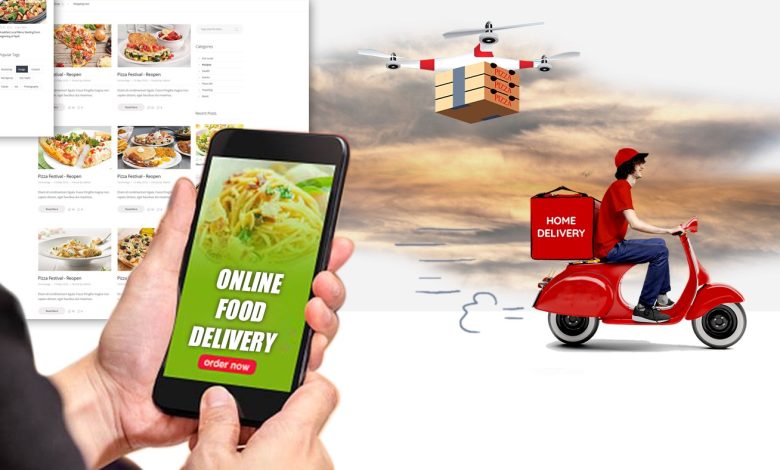7 Trends Driving Changes in Online Food Ordering and Delivery Business

The online food ordering and delivery industry is undergoing a fundamental shift. This shift is being driven by high-speed internet and a surge in smartphone usage. The market’s enormous potential has resulted in the growth of multiple on-demand food ordering apps, each with its Unique Selling Proposition (USP).
According to current statistics, the global food delivery industry is now valued at $95 billion and is expected to expand by 9.8% by 2026. This will happen as a result of increased spending power, a wide range of restaurant selections, hectic schedules that allow little time for preparation, and aggressive marketing by top corporations.
The sector is dominat by UberEats, Zomato, GrubHub, Doordash, JustEat, and other well-known online food ordering services. Due to increased rivalry, developing technical trends, and changing customer expectations, firms must upgrade their systems and add distinctive advancements to suit demands. So, let us discuss the biggest trends in the Online Food Ordering Industry.
New Channels to Place Orders
According to statistics, over 55% of consumers in the United States prefer to order online. The major reason for this is that people can quickly order food via a variety of on-demand food ordering platforms.
Order with Tweet
Domino’s is the first company to take orders for food over Twitter. The user must first register a Dominos account and have their Twitter account approved. They can instantly place an order by tweeting to the Dominos account. They can also save their favourite orders and use “Easy order” to repeat them.
Food Order with Smart Watches
Nowadays, there are a lot of smart clocks on the market. According to statistics, 141 million smartwatches were sold in 2018, prompting the food ordering app development for restaurant for both Android and iOS. The first restaurant to employ it was Domino’s.
Order with Virtual Assistance
The popularity of virtual assistance continues in the food delivery industry, with Dominos leading the way. Domino’s introduced “DOM,” a virtual assistant on Facebook, to help consumers converse and place orders. The DOM is in charge of distributing menu information and taking client orders.
Order with Car
In order to better manage customers’ time, Pizza Hut has joined up with Accenture and Visa to build an online food ordering system for vehicles. The user may instantly order meals from the car while driving to work or home.
Order with Smart TV
People may order meals from smart televisions while watching movies. Papa’s Johnny, in collaboration with Apple, has developed a television-based food ordering system that allows customers to explore the whole menu and place orders. On its televisions, Samsung launched “TakeAway.” so that people may quickly order food from nearby restaurants.
Modern delivery options
Drone
The novel concept of employing a drone to deliver food is all the rage these days. Zomato recently put their hybrid Drone to the test in terms of food delivery. This concept’s major goal is to lower the time restriction from 30 to 15 minutes. It’s a clever way to avoid traffic while maintaining social distance.
Robots
Eat24 has begun delivering meals with table-sized robots in collaboration with Yelp and Marble. To determine the consumer’s address, the robot has sensors, cameras, and a 3D city map integrated. The robot on the wheel avoids collisions with bumpers, humans, and other automobiles after deciding the most direct course.
Parachute
The first company to employ a food delivery parachute was in Melbourne. Customers are instructed to wait for the X-shaped object on the balcony at the allotted time. After some time, a gorgeous small parachute will fly into the sky.
Proper Assistance of Millenials
Millennials are increasing their expenditure on online meal delivery services provided by restaurants. According to annual reports published by mobile apps like UberEats, Zomato, and GrubHub, the spending and eating habits of twenty- to thirty-year-olds on meals and takeaway have been continuously growing. The majority of the on-demand food ordering app business is dominate by ‘Generation Y.’
In the modern era, cooked food and certain shopping goods are deliver to people’s doors. So, to meet the needs of these generations while also adhering to their financial constraints, an online meal ordering system for restaurants provides services that they require. Focusing on a specific audience allows you to receive a greater amount of rewards than focusing on a larger population.
Cloud Kitchen
Cloud kitchens are on the verge of changing the restaurant sector. A cloud/ghost/virtual kitchen is an arrangement in which a major restaurant leases out space to make delivery-optimized menu items. A restaurant can run many brands that serve the same clients under one roof. Virtual or cloud kitchens are expected to be worth $365 billion by 2030, according to Swiss bank estimates.
The Ultimate- Big Data
In today’s world, big data analysis is becoming more important. This strategy can be use by online food delivery applications to gather accurate results from consumers, enhancing reliability and eliminating delays. Businesses can utilise Big Data information to determine consumer moods, delivery times, and customised offers, among other things. Online food ordering and delivery business owners may utilise Big Data to examine a variety of data, including:
- Real-time traffic alerts
- Order history
- Customers can provide feedback on social media platforms.
Big Data Technologies, on the other hand, may be utilized by online restaurant ordering software to forecast data and respond to consumer demands as rapidly as possible.
Digital Currency Payment
Cryptocurrency is a new digital payment system that acts as a medium of exchange for financial transactions between the two parties. This technology is known as ‘Blockchain,’ and it has been use to support digital money.
Customers who order meals through a restaurant’s online food delivery service can pay with cryptocurrency. There are no cheats during transactions due to the high degree of security provided by this technology. Later on, it might be a one-of-a-kind feature to improve the user’s experience.
QR Code Technology
Nowadays, if you go to a restaurant, you will not be given a print menu. Instead, they recommend scanning QR codes to have immediate access to comprehensive menus. It’s convenient, and customers can be sure that they’re the only ones who touch their devices.
This trend originated in the United Kingdom and has now spread around the world. The most important requirement, though, is a smartphone with a QR code capability. The consumer experience has been enhanced as a result of this business innovation.
In a Nutshell
Due to all innovations and technology advancements, client expectations are growing. As a result, modern food ordering and delivery platforms must stay on top of industry trends and devise tactics to maximize consumer satisfaction while also generating sustainable revenue.
Be aware of and follow these trends in food delivery to your consumers to stay ahead of the competition in the food industry. Hire a food ordering app development company to develop a food ordering app utilizing cutting-edge technologies.




